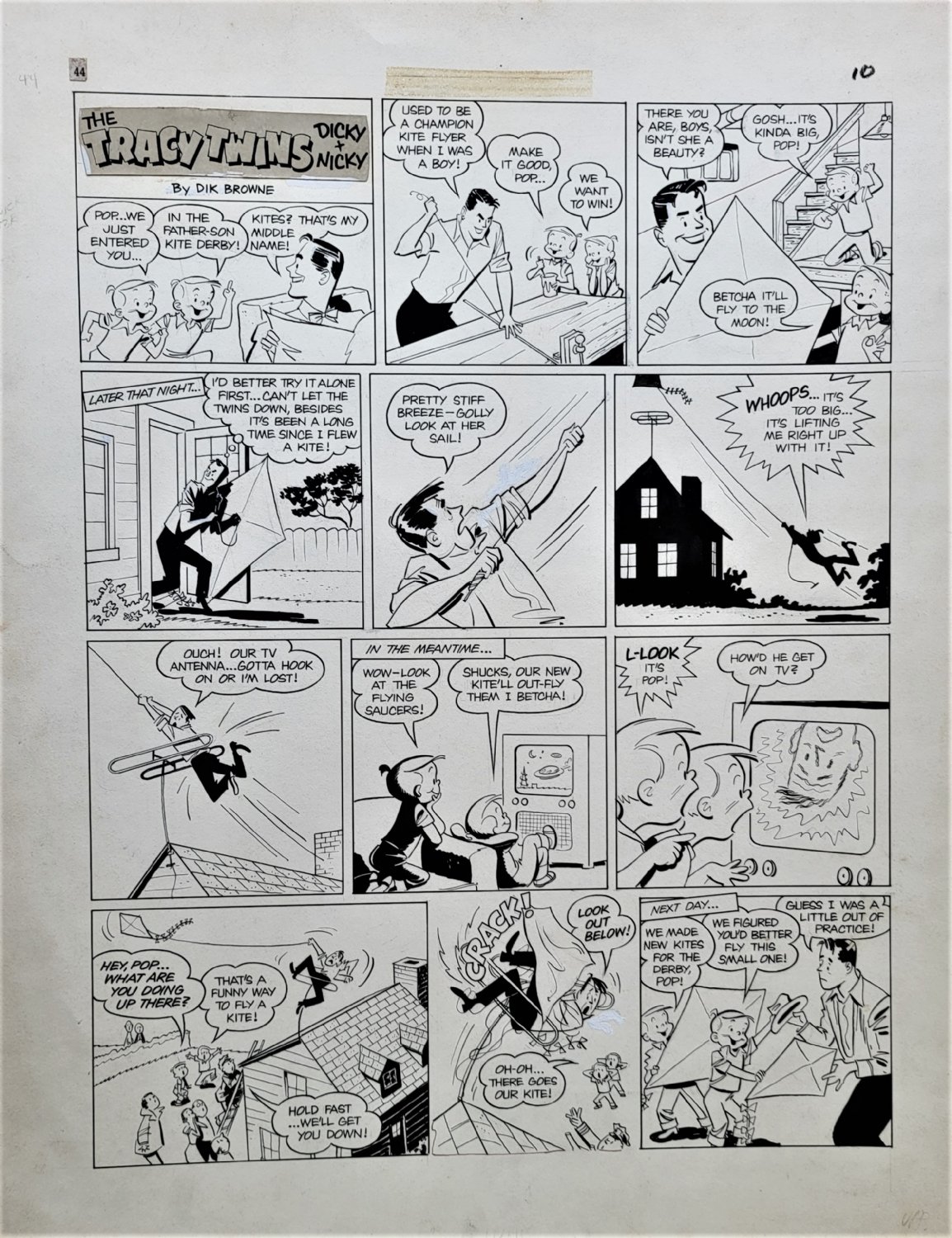 |
| Home | Comic Art by Artist | Comic Art by Gallery | Comic Art by Genre | NEW Art! | Art for Trade | Want List | Links | News | Ordering/Contact |
|
|
Dik Browne BROWNE, DIK - Tracy Twins Sunday format 1950's(?) Historic strip that led to Dik's job on Hi and Lois! Very rare example, most Boy's Life artwork from the early period seems to have been discarded.
A banner headline on the cover of the September 1952 issue of Boys’ Life announced a new addition to the magazine: “FEATURING AN 8 PAGE SUPPLEMENT IN FULL COLOR.” This was the debut of a color comic section edited by Al Stenzel, an art director at the Johnstone and Cushing art agency. Inside were eight single-page features: Pee Wee Harris, The Story of Creation, Mog-An-Ah—The Mound Builder, Old Timer Tale of Kit Carson, Space Conquerors, How to Make It…, Emanon Dreemz in the Mail Must Go Through and Scouts in Action. A new monthly feature, The Tracy Twins – Dicky + Nicky by Dik Browne, made its first appearance in the October 1953 issue of Boys’ Life. One of the top cartoonists at Johnstone and Cushing, Browne had worked on a number of successful advertising campaigns including Colonel Mint, Roger Wilco, Peter Paul Playhouse, Camel Cigarettes and Lipton Tea. He is credited with designing the iconic Chiquita banana lady and reinventing the Campbell Soup kids, who were created by Grace Drayton in 1905. In the early 1950s, Browne did a series of ads for Vaseline petroleum jelly starring The Trouble Twins. These cherubic mischief-makers closely resembled the twins he would later introduce in Boys’ Life. Browne once described his early style as “sort of between Peter Arno and Harry Haenigsen [creator of the comic strip Penny].” Among his many influences were such artists as Kimon Nicolaides, author of The Natural Way to Draw, surrealist Boris Artzybasheff and Heinrich Kley, a master of pen and ink. Stenzel produced large pencil layouts of the Tracy Twins pages on tracing paper with extensive directions on staging, costumes and historical details, since many of the episodes contained flashbacks and elements of fantasy and folklore. Chance Browne, Dik's son, described what these layouts looked like: “Stenzel’s drawings would be in vignette form, roughed in with a lot of notations and problem solving. They looked like a storyboard. He had a very naturalistic feeling for people, which my Dad brought to life. There was less design and more articulated anatomy, posing the characters in situations. A lot of thought went into it because of what they were trying to show in terms of the items in the panels and the people. “It was great to have a cartoon in which kids could relate to the characters. It wasn’t written down to them. Al Stenzel did a great job on these. Everything he wrote was really smart. He could get really wacky, too. There was some true adventurousness in the writing that gave rise to these drawings.” In the January 1954 episode of the Tracy Twins, Dicky and Nicky’s grandfather, an old gent with a bowtie and suspenders who loved telling tall tales about past exploits and long-lost relatives, made his first appearance. Grandpa became an integral member of the cast along with a set of typical 1950s baby boomer parents. Most of the plots revolved around clever schemes, often inspired by Grandpa’s stories, which inevitably backfired. “I love the relationship between the grandfather and the twins,” Chance said. “It skipped a generation. They were partners in crime. There’s an innocence in it that seems to be missing today.” Johnstone and Cushing and the Tracy Twins led directly to a career-changing opportunity for Dik. In 1954, Mort Walker, the creator of Beetle Bailey, and Sylvan Byck, the comics editor of King Features Syndicate, were looking for an artist to draw a new family comic strip that was a spinoff of Beetle. Mort had seen a Peter Paul Playhouse advertisement; one of the few assignments Dik had signed. Sylvan picked up a copy of Boys’ Life while waiting in his dentist’s office and discovered the Tracy Twins. When they got together, Mort and Sylvan noticed that the same name had been added to both of their lists. Sylvan called Dik at Johnstone and Cushing and asked him if he would be interested in drawing a nationally syndicated comic strip. At first, Dik thought his coworker, Stan Drake, was playing another practical joke on him, but eventually he called Byck back and agreed to a meeting. The new strip debuted on October 18, 1954. “When Hi and Lois happened, everything took shape for him in his life. It was the best thing that ever happened to him,” Chance remarked.
for sale
 PLEASE NOTE: Adding and item to your Basket helps you easily create a Purchase Request on this web site. You are not asked to enter credit card information when you complete your Purchase Request. EMAIL US if you have a Question. |

|
|
Comments or Questions regarding the website? |
Box 843 Colfax, CA., 95713 |
©2024 Coollinesartwork.com, All rights reserved.
|
Home |
Comic Art by Artist |
Comic Art by Gallery |
Comic Art by Genre |
NEW Art! Art for Trade | Want List | Links | News | Ordering/Contact | Privacy & Cookie Policy |
 |